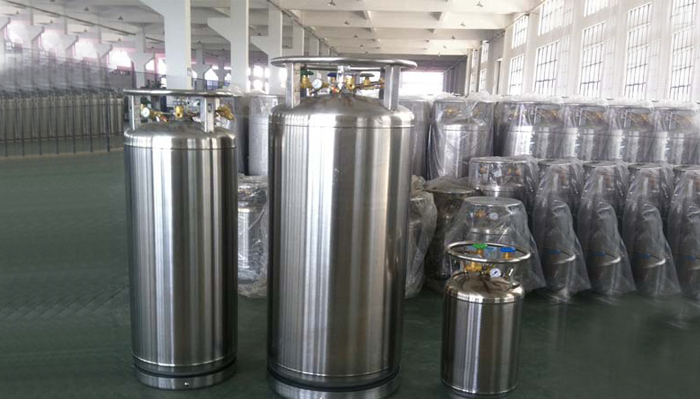Product Category
Basic properties of liquid nitrogen dewar
Date: Jul 15, 2020

Liquid nitrogen dewars are super vacuum insulated stainless steel pressure vessels designed for storage, transportation, and use of liquid oxygen, liquid nitrogen, liquid argon, or carbon dioxide. It is used for reliable and economical transportation and storage of cryogenic liquid gas, and in-situ storage and supply of cryogenic liquid gas in a wide range of applications.
Liquid nitrogen dewars have two main advantages:
The first is that it can hold a large amount of gas at a relatively low pressure compared to compressed gas cylinders.
The second is that it provides a cryogenic liquid source that is easy to handle. Due to the sturdiness and reliability of the Dewar, its long holding time, and its own gas supply system, the built-in carburetor can continuously output normal temperature gas (oxygen, nitrogen, argon) with a flow rate of up to 10m3/h, and the maximum constant output pressure of the gas is 1.2MPa (Medium pressure type)/2.2 MPa (high pressure type), fully meet the gas requirements under normal circumstances. If the gas flow of the user is large, multiple Dewars can be connected in parallel or an external carburetor can be added to meet the gas supply requirements. By installing an external carburetor, the maximum output flow of a single Dewar can reach 50m3/h. The main points of liquid nitrogen dewar filling:
The main points of liquid nitrogen dewar filling:
1. Be careful when filling with liquid nitrogen. For new liquid nitrogen tanks or liquid nitrogen dewars in a dry state, they must be filled slowly and pre-cooled to prevent damage to the inner bladder due to rapid cooling and reduce the service life.
2. When filling liquid nitrogen, do not pour liquid nitrogen on the vacuum exhaust port, so as not to cause the vacuum to drop.
3. The cover plug is made of heat-insulating material, which can not only prevent the evaporation of liquid nitrogen, but also play the role of fixing the lifting cylinder, so the wear and tear should be minimized when switching to extend the service life.
4. Liquid nitrogen tanks should be stored in a well-ventilated and cool place, and should not be exposed to direct sunlight. Due to its manufacturing precision and its inherent characteristics, no matter when it is used or stored, the liquid nitrogen tank is not allowed to be tilted, laid horizontally, inverted, stacked, collided with each other or collided with other objects. It should be handled gently and always maintained upright.
Liquid nitrogen dewars have two main advantages:
The first is that it can hold a large amount of gas at a relatively low pressure compared to compressed gas cylinders.
The second is that it provides a cryogenic liquid source that is easy to handle. Due to the sturdiness and reliability of the Dewar, its long holding time, and its own gas supply system, the built-in carburetor can continuously output normal temperature gas (oxygen, nitrogen, argon) with a flow rate of up to 10m3/h, and the maximum constant output pressure of the gas is 1.2MPa (Medium pressure type)/2.2 MPa (high pressure type), fully meet the gas requirements under normal circumstances. If the gas flow of the user is large, multiple Dewars can be connected in parallel or an external carburetor can be added to meet the gas supply requirements. By installing an external carburetor, the maximum output flow of a single Dewar can reach 50m3/h.

1. Be careful when filling with liquid nitrogen. For new liquid nitrogen tanks or liquid nitrogen dewars in a dry state, they must be filled slowly and pre-cooled to prevent damage to the inner bladder due to rapid cooling and reduce the service life.
2. When filling liquid nitrogen, do not pour liquid nitrogen on the vacuum exhaust port, so as not to cause the vacuum to drop.
3. The cover plug is made of heat-insulating material, which can not only prevent the evaporation of liquid nitrogen, but also play the role of fixing the lifting cylinder, so the wear and tear should be minimized when switching to extend the service life.
4. Liquid nitrogen tanks should be stored in a well-ventilated and cool place, and should not be exposed to direct sunlight. Due to its manufacturing precision and its inherent characteristics, no matter when it is used or stored, the liquid nitrogen tank is not allowed to be tilted, laid horizontally, inverted, stacked, collided with each other or collided with other objects. It should be handled gently and always maintained upright.
Last article:
Next article:
Send Your Inquiry
We not only provide a good product, but also provide high quality service. If you are interested in our products,
you can contact us in the following ways.
you can contact us in the following ways.







